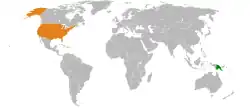 | |
Papua New Guinea |
United States |
|---|---|
Papua New Guinea–United States relations refers to the diplomatic relations between Papua New Guinea and the United States of America. The two countries established diplomatic relations following Papua New Guinea's independence on September 16, 1975. The two nations belong to a variety of regional organizations, including the Asia-Pacific Economic Cooperation (APEC) forum; the ASEAN Regional Forum (ARF); the Pacific Community (SPC); and the South Pacific Regional Environmental Program (SPREP).
The U.S. maintains an embassy in Port Moresby, Papua New Guinea. Papua New Guinea has an embassy in Washington, D.C.[1]
History

The United States and Papua New Guinea established diplomatic relations upon the latter's independence on September 16, 1975.
The U.S. Peace Corps ceased operations in Papua New Guinea in 2001 due to security concerns. About 2,000 U.S. citizens live in Papua New Guinea, with major concentrations at the headquarters of New Tribes Mission (a missionary organization), and the Summer Institute of Linguistics, both located in the Eastern Highlands Province.
In May 2023, a defense agreement was announced between the two countries.[2][3][4] The PNG Prime Minister James Marape agreed to release the full details of the agreement but categorically stated that the US would be prohibited from launching an offensive war from the Island. The agreement is seen as a part of the on-going tension between the United States and China over influence in the region.[5] On 22 May, the United States and Papuan governments formally signed two defence and maritime agreements.[6] The agreements permit use of Lombrum Naval Base and Momote Airport.[7] In response, students from several Papuan universities including the Papua New Guinea University of Technology, University of Goroka, and University of Papua New Guinea staged protests to coincide with the signing of the bilateral security treaty, calling for transparency and clarity.[8][9]
References
- ↑ "Embassy of Papua New Guinea to the Americas". Retrieved 15 May 2016.
- ↑ Needham, Kirsty (2023-05-10). "Biden to sign defence pact in Papua New Guinea, with eyes on China". Reuters. Retrieved 2023-05-10.
- ↑ "U.S. eyes access to Papua New Guinea naval base and airport". Nikkei Asia. May 14, 2023. Retrieved 2023-05-14.
- ↑ Kuku, Rebecca (2023-05-22). "US and Papua New Guinea sign pact amid Pacific militarisation concerns". The Guardian. ISSN 0261-3077. Retrieved 2023-05-23.
- ↑ "Papua New Guinea won't be base 'for war to be launched', says PM, after US security deal". The Guardian. 2023-05-23. Retrieved 2023-05-23.
- ↑ Perry, Nick (22 May 2023). "US signs new security pact with Papua New Guinea amid competition with China". Stuff. Archived from the original on 24 May 2023. Retrieved 24 May 2023.
- ↑ "U.S. military to use Papua New Guinea naval base for 15 years". Nikkei Asia. July 19, 2023. Retrieved 2023-07-19.
- ↑ Waide, Scott; Lewis, Lydia (22 May 2023). "'There must be clarity': PNG students protest US defence deal". Radio New Zealand. Retrieved 24 May 2023.
- ↑ "'Two-way highway' – PNG-US defence pact signed in spite of protests". Asia Pacific Report. 23 May 2023. Retrieved 24 May 2023.
![]() This article incorporates public domain material from U.S. Bilateral Relations Fact Sheets. United States Department of State.
This article incorporates public domain material from U.S. Bilateral Relations Fact Sheets. United States Department of State.
